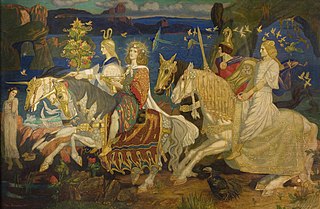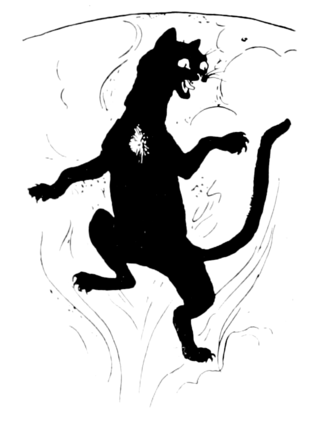
Aos sí is the Irish name for a supernatural race in Gaelic folklore, similar to elves. They are said to descend from the Tuatha Dé Danann or the gods of Irish mythology.
Annwn, Annwfn, or Annwfyn is the Otherworld in Welsh mythology. Ruled by Arawn, it was essentially a world of delights and eternal youth where disease was absent and food was ever-abundant.

Gwyn ap Nudd is a Welsh mythological figure, the king of the Tylwyth Teg or "fair folk" and ruler of the Welsh Otherworld, Annwn, and whose name means “Gwyn, son of Nudd”. Described later on as a great warrior with a "blackened face", Gwyn is intimately associated with the otherworld in medieval Welsh literature, and is associated with the international tradition of the Wild Hunt.

In Welsh mythology, Arawn was the king of the otherworld realm of Annwn who appears prominently in the first branch of the Mabinogi, and alluded to in the fourth. In later tradition, the role of the king of Annwn was largely attributed to the Welsh psychopomp, Gwyn ap Nudd - meaning "white" a possible kenning for his true name. However, Arawn's memory is retained in a traditional saying found in an old Cardigan folktale:

In Gaelic myth, the Cailleach is a divine hag and ancestor, associated with the creation of the landscape and with the weather, especially storms and winter. The word literally means 'old woman, hag', and is found with this meaning in modern Irish and Scottish Gaelic, and has been applied to numerous mythological and folkloric figures in Ireland, Scotland, and the Isle of Man. In modern Irish folklore studies, she is sometimes known as The Hag of Beara, while in Scotland she is known as Beira, Queen of Winter.
In Welsh mythology and folklore, Cŵn Annwn, singular Ci Annwn, were the spectral hounds of Annwn, the otherworld of Welsh myth. They were associated with a form of the Wild Hunt, presided over by either Arawn, king of Annwn in Pwyll Pendefig Dyfed, the First Branch of the Mabinogi and alluded to in Math fab Mathonwy the Fourth Branch of the Mabinogi, or by Gwyn ap Nudd as the underworld king and king of the fair(y) folk is named in later medieval lore.

A kelpie, or water kelpie, is a mythical shape-shifting spirit inhabiting lochs in Scottish folklore. It is usually described as a grey or white horse-like creature, able to adopt human form. Some accounts state that the kelpie retains its hooves when appearing as a human, leading to its association with the Christian idea of Satan as alluded to by Robert Burns in his 1786 poem "Address to the Devil".

In Celtic mythology, the Otherworld is the realm of the deities and possibly also the dead. In Gaelic and Brittonic myth it is usually a supernatural realm of everlasting youth, beauty, health, abundance and joy. It is described either as a parallel world that exists alongside our own, or as a heavenly land beyond the sea or under the earth. The Otherworld is usually elusive, but various mythical heroes visit it either through chance or after being invited by one of its residents. They often reach it by entering ancient burial mounds or caves, or by going under water or across the western sea. Sometimes, they suddenly find themselves in the Otherworld with the appearance of a magic mist, supernatural beings or unusual animals. An otherworldly woman may invite the hero into the Otherworld by offering an apple or a silver apple branch, or a ball of thread to follow as it unwinds.

Scottish mythology is the collection of myths that have emerged throughout the history of Scotland, sometimes being elaborated upon by successive generations, and at other times being rejected and replaced by other explanatory narratives.

A hellhound is a mythological hound that embodies a guardian or a servant of hell, the devil, or the underworld. Hellhounds occur in mythologies around the world, with the best-known examples being Cerberus from Greek mythology, Garmr from Norse mythology, the black dogs of English folklore, and the fairy hounds of Celtic mythology. Physical characteristics vary, but they are commonly black, anomalously overgrown, supernaturally strong, and often have red eyes or are accompanied by flames.

The cat-sìth, in Irish cat sí, is a fairy creature from Celtic mythology, said to resemble a large black cat with a white spot on its chest. Legend has it that the spectral cat haunts the Scottish Highlands. The legends surrounding this creature are more common in Scottish folklore, but a few occur in Irish. Some common folklore suggested that the cat-sìth was not a fairy, but a witch that could transform into a cat nine times.

The Kellas cat is a large black cat found in Scotland. It is an interspecific hybrid between the Scottish wildcat and the domestic cat. Once thought to be a mythological wild cat, with its few sightings dismissed as hoaxes, a specimen was killed in a snare by a gamekeeper in 1984 and found to be a hybrid between the Scottish wildcat and domestic cat. It is not a formal cat breed, but a population of felid hybrids. It is named after the village of Kellas, Moray, where it was first found.
The baobhan sith is a female fairy in the folklore of the Scottish Highlands, though they also share certain characteristics in common with the succubus. They appear as beautiful women who seduce their victims before attacking them and killing them.
The bean-nighe is a female spirit in Scottish folklore, regarded as an omen of death and a messenger from the Otherworld. She is a type of ban-sìth that haunts desolate streams and washes the clothing of those who are about to die. Les Lavandières is the French word under which these "night washerwomen" are perhaps best known. She is also called nigheag, 'the little washer', nigheag na h-ath, 'little washer of the ford', or nigheag bheag a bhroin, 'little washer of the sorrow'.

The black dog is a supernatural, spectral, or demonic hellhound originating from English folklore, and also present in folklore throughout Europe and the Americas. It is usually unnaturally large with glowing red or yellow eyes, is often connected with the Devil, and is sometimes an omen of death. It is sometimes associated with electrical storms, and also with crossroads, barrows, places of execution and ancient pathways.
The caoineag is a female spirit in Scottish folklore and a type of Highland banshee, her name meaning "weeper". She is normally invisible and foretells death in her clan by lamenting in the night at a waterfall, stream or Loch, or in a glen or on a mountainside. Unlike the related death portent known as the bean nighe, the caoineag cannot be approached, questioned, or made to grant wishes.

John Gregorson Campbell was a Scottish folklorist and Free Church minister at the Tiree and Coll parishes in Argyll, Scotland. An avid collector of traditional stories, he became Secretary to the Ossianic Society of Glasgow University in the mid-1850s. Ill health had prevented him taking up employment as a Minister when he was initially approved to preach by the Presbytery of Glasgow in 1858 and later after he was appointed to Tiree by the Duke of Argyll in 1861, parishioners objected to his manner of preaching.

The blue men of the Minch, also known as storm kelpies, are mythological creatures inhabiting the stretch of water between the northern Outer Hebrides and mainland Scotland, looking for sailors to drown and stricken boats to sink. They appear to be localised to the Minch and surrounding areas to the north and as far east as Wick, unknown in other parts of Scotland and without counterparts in the rest of the world.
Gwragedd Annwn, alternatively known as Dames of the Lower Region, Dames of Elfin Land, or Wives of the Lower World, are beautiful female fairies who live beneath lakes and rivers found in Welsh folklore. They are counted among the Tylwyth Teg or Welsh fairy folk.The mythological narrative of Gwragedd Annwn is intertwined with the origin of the Welsh black cattle. Some legends hold that the existence of the Gwragedd Annwn was owed to the famed Saint Patrick. Occasionally, the fairies were said to ascend into the upper world, and be visible to ordinary people.
Brenin Llwyd, is a legendary figure in Welsh mythology. Recorded in mountainous locations throughout the country, the figure is always silent, semi-corporeal, is cloaked in mist or a grey cloak and preys on unwary travellers, especially children.













